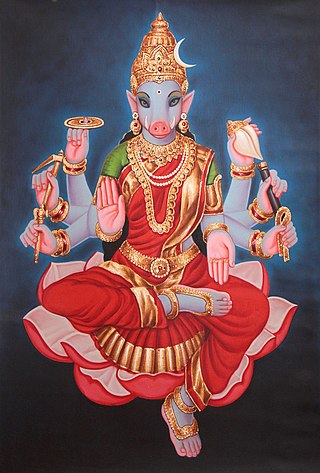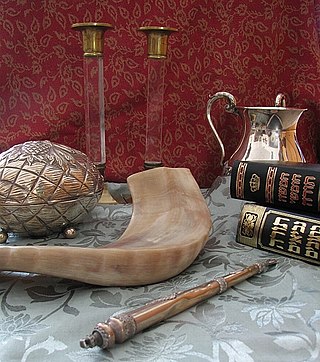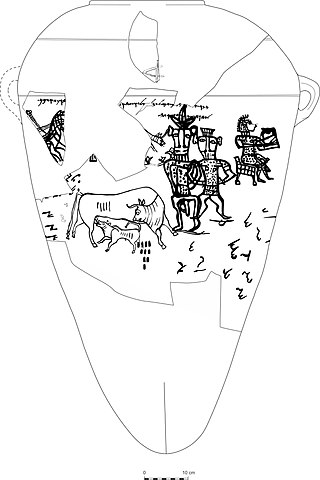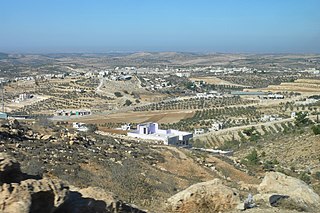
A goddess is a female deity. In many known cultures, goddesses are often linked with literal or metaphorical pregnancy or imagined feminine roles associated with how women and girls are perceived or expected to behave. This includes themes of spinning, weaving, beauty, love, sexuality, motherhood, domesticity, creativity, and fertility. Many major goddesses are also associated with magic, war, strategy, hunting, farming, wisdom, fate, earth, sky, power, laws, justice, and more. Some themes, such as discord or disease, which are considered negative within their cultural contexts also are found associated with some goddesses. There are as many differently described and understood goddesses as there are male, shapeshifting, or neuter gods.

Yahweh was an ancient Levantine deity, and national god of the Israelite kingdoms of Israel and Judah. Though no consensus exists regarding the deity's origins, scholars generally contend that Yahweh emerged as a "divine warrior" associated first with Seir, Edom, Paran and Teman, and later with Canaan. The origins of his worship reach at least to the early Iron Age, and likely to the Late Bronze Age, if not somewhat earlier.
Shechinah, (Hebrew: שְׁכִינָה Šḥīnā, is the English transliteration of a Hebrew word meaning "dwelling" or "settling" and denotes the presence of God, as it were, in a place. This concept is found in Judaism.

A mother goddess is a major goddess characterized as a mother or progenitor, either as an embodiment of motherhood and fertility or fulfilling the cosmological role of a creator- and/or destroyer-figure, typically associated the Earth, sky, and/or the life-giving bounties thereof in a maternal relation with humanity or other gods. When equated in this lattermost function with the earth or the natural world, such goddesses are sometimes referred to as the Mother Earth or Earth Mother, deity in various animistic or pantheistic religions. The earth goddess is archetypally the wife or feminine counterpart of the Sky Father or Father Heaven, particularly in theologies derived from the Proto-Indo-European sphere. In some polytheistic cultures, such as the Ancient Egyptian religion which narrates the cosmic egg myth, the sky is instead seen as the Heavenly Mother or Sky Mother as in Nut and Hathor, and the earth god is regarded as the male, paternal, and terrestrial partner, as in Osiris or Geb who hatched out of the maternal cosmic egg.

Asherah is a fertility goddess in ancient Semitic religion who appears in a number of ancient sources. She also appears in Hittite writings as Ašerdu(s) or Ašertu(s). Her name is sometimes rendered Athirat in the context of her cult at Ugarit.

Astarte is the Hellenized form of the Ancient Near Eastern goddess ʿAṯtart. ʿAṯtart was the Northwest Semitic equivalent of the East Semitic goddess Ishtar.
Idolatry in Judaism is prohibited. Judaism holds that idolatry is not limited to the worship of an idol itself, but also worship involving any artistic representations of God. The prohibition is epitomized by the first two "words" of the decalogue: I am the Lord thy God, Thou shalt have no other gods before me, and Thou shalt not make unto thee any graven image or any image in the sky, on earth or in the sea. These prohibitions are re-emphasized repeatedly by the later prophets, suggesting the ongoing appeal of Canaanite religion and syncretic assimilation to the ancient Israelites.

An Asherah pole is a sacred tree or pole that stood near Canaanite religious locations to honor the goddess Asherah. The relation of the literary references to an asherah and archaeological finds of Judaean pillar-figurines has engendered a literature of debate.

The Canaanite religion was the group of ancient Semitic religions practiced by the Canaanites living in the ancient Levant from at least the early Bronze Age through the first centuries AD. Canaanite religion was polytheistic and, in some cases, monolatristic.
Tikva Simone Frymer-Kensky was a professor at the University of Chicago Divinity School. She received her MA and PhD from Yale University. She had previously served on the faculties of Wayne State University, the Jewish Theological Seminary of America, Yale University, Ben Gurion University, and the Reconstructionist Rabbinical College, where she served as director of Biblical studies.
Raphael Patai, born Ervin György Patai, was a Hungarian-Jewish ethnographer, historian, Orientalist and anthropologist.
William Gwinn Dever is an American archaeologist, scholar, historian, semiticist, and theologian. He is an active scholar of the Old Testament, and historian, specialized in the history of the Ancient Near East and the ancient kingdoms of Israel and Judah in biblical times. He was Professor of Near Eastern Archaeology and Anthropology at the University of Arizona in Tucson from 1975 to 2002. He is a Distinguished Professor of Near Eastern Archaeology at Lycoming College in Pennsylvania.
Did God Have a Wife?: Archaeology and Folk Religion in Ancient Israel is a book by Syro-Palestinian archaeologist William G. Dever, Professor Emeritus of Near Eastern Archeology and Anthropology at the University of Arizona. Did God Have a Wife? was intended as a popular work making available to the general public the evidence long known to archaeologists regarding ancient Israelite religion: namely that the Israelite God of antiquity, Yahweh, had a consort, that her name was Asherah, and that she was part of the Canaanite pantheon.
Queen of Heaven was a title given to a number of ancient sky goddesses worshipped throughout the ancient Mediterranean and the ancient Near East. Goddesses known to have been referred to by the title include Inanna, Anat, Isis, Nut, Astarte, and possibly Asherah. In Greco-Roman times, Hera and Juno bore this title. Forms and content of worship varied.

The origins of Judaism lie in the Bronze Age amidst polytheistic ancient Semitic religions, specifically evolving out of the polytheistic ancient Canaanite religion, then co-existing with Babylonian religion, and syncretizing elements of Babylonian belief into the worship of Yahweh as reflected in the early prophetic books of the Hebrew Bible.
Semitic neopaganism is a group of religions based on or attempting to reconstruct the ancient Semitic religions, mostly practiced among Jews in the United States.

Kuntillet Ajrud is a late 9th/early 8th centuries BCE site in the northeast part of the Sinai Peninsula. It is frequently described as a shrine, though this is not certain.

Khirbet el-Qom is an archaeological site in the village of al-Kum, West Bank, in the territory of the biblical Kingdom of Judah, between Lachish and Hebron, 14 km to the west of the latter.

A ceremonial pole is a stake or post utilised or venerated as part of a ceremony or religious ritual. Ceremonial poles may symbolize a variety of concepts in different ceremonies and rituals practiced by a variety of cultures around the world. In many cultures, ceremonial poles represent memorials and gravemarkers. In The Evolution of the Idea of God, Grant Allen notes that Samoyeds of Siberia, and Damara of South Africa plant stakes at the graves of ancestors. Ceremonial poles may also be raised during celebrations and festivals, as with Gudi Padwa in Indian State of Maharashtra and the maypole dance in Europe. In some cultures they may represent sacred trees or tools wielded by deities. They may also symbolise the axis mundi or world tree. In religious ceremonies, they may be venerated as idols or representations of tutelary deities.

Yahwism is the name given by modern scholars to the religion of ancient Israel and Judah. Yahwism was essentially polytheistic, with a plethora of gods and goddesses. Heading the pantheon was Yahweh, the national god of the Israelite kingdoms of Israel and Judah, with his consort, the goddess Asherah, and second-tier gods and goddesses such as Baal, Shamash, Yarikh, Mot, and Astarte, each of whom had their own priests and prophets and numbered royalty among their devotees.










